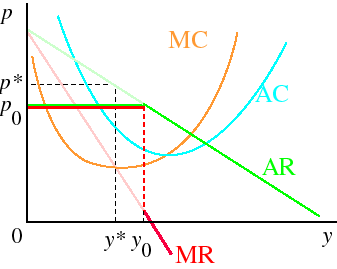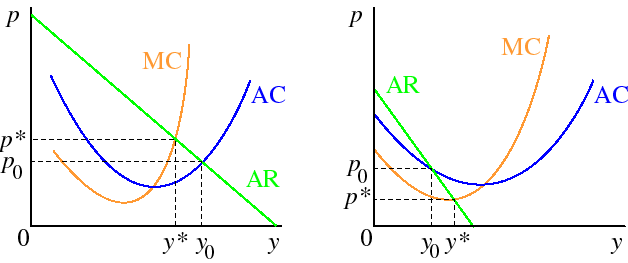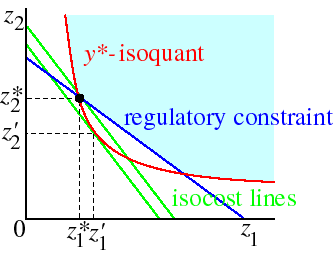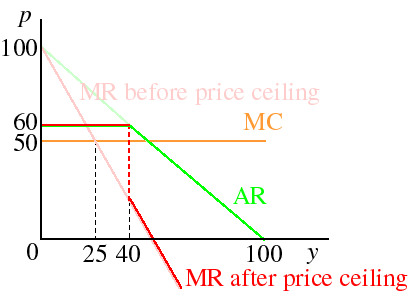6.4 Policies to control a monopoly
If there is only one firm in the industry because of some artificial restriction, then one possibility is to remove that restriction—if the outcome that results after the restriction is lifted is likely to be better than the monopoly outcome. But if the industry is a natural monopoly then lifting a restriction to entry will not in fact induce entry—in this case, an entrant cannot make a profit (the market is not big enough to support more than one firm).
Three ways in which the monopolist might be controlled are considered in the following sections.
Price ceilings
Suppose a price ceiling is imposed. How does this affect the monopolist's revenue curves?Suppose the monopolist is not allowed to charge a price above p0. Then if it sells less than is demanded at p0 it must do so at the price p0 (rather than at a higher price), and so its marginal revenue is p0. If it sells more than is demanded at the price p0 then the price is the same as it is in the absence of any restriction, and hence its marginal revenue is the same as it was originally. Thus its marginal revenue has a discontinuity, as in the following figure.

In the presence of the restriction, the firm's optimal output is y0 (note that its profit at this output is positive), where the marginal revenue has a discontinuity: for smaller outputs MR exceeds MC, and for larger outputs MR is less than MC. The outcome of the regulation is thus that the price falls to p0 (from its original value p*) and output increases from y* to y0.
If the regulated price ceiling is exactly the competitive price then if the firm makes a profit, it is induced to produce the efficient output. If it does not make a profit at this output, then a subsidy, in addition to a price ceiling, is necessary to induce the firm to produce the efficient output.
Notice that in order to set the price ceiling exactly at the level that induces the firm to produce the efficient output, the regulator has to know the firm's marginal cost curve. (And if the firm knows how the information about its MC is going to be used by the regulator, obviously it has an incentive not to reveal what it is.)
Average cost pricing
Suppose that the government requires the monopoly to set a price equal to average cost. That is, it requires the firm to choose an (output, price) pair for which AC is equal to AR. This regulation eliminates profit, but does not necessarily lead to an efficient outcome.The outcome that this regulation produces is illustrated in the figure. In the left panel the output y0 under the regulation is larger than the efficient output y*, while in the right panel it is less than the efficient output. (In both cases the curves are drawn so that there is only one output at which AC and AR are equal; in other cases there may be more than one such output.)

Rate-of-return regulation
A common form of control in the US and Canada is rate-of-return regulation: the rate of return on invested capital is capped. This regulation results in a monopolist using more capital than it would if it were unregulated, given its output.To see this, suppose that a firm uses capital (input 2) and another input (1). The return on capital is
If r = w2 then rate-of-return regulation is equivalent to average cost pricing: it requires the firm to make zero profit. Assume that r > w2. Then under rate-of-return regulation the firm's profit-maximization problem is:
Let (y*,z*1,z*2) be a solution of this problem. Consider the y*-isoquant. The regulation requires that the firm use a pair of inputs satisfying the regulatory constraint TR(y) ≤ w1z1 + rz2; that is, a pair (z1, z2) above the line TR(y) = w1z1 + rz2. The slope of this line is −w1/r (write z2 as a function of z1), so since r > w2, the line is not as steep as an isocost line. Note that as r changes, the line pivots around the point it intersects the z1 axis.
The problem of the firm is represented in the following figure. The firm has to choose an input bundle (z1, z2) on or above the y*-isoquant and on or above the regulatory constraint (i.e. in the area shaded light blue); it wants to choose the one that is on the lowest possible isocost line. The point in the figure that satisfies this condition is (z*1, z*2). In the absence of regulation the firm would use the input bundle (z'1, z'2).

Thus we see that the firm uses more of input 2 than if would if it were unregulated: the output is not produced at minimal cost. If the input prices reflect their social costs (as they do in a competitive equilibrium of the input markets) then the outcome is inefficient. Of course, this inefficiency has to be balanced against any change in the output of the monopolist in the direction of the efficient output, and also against any change in the distribution of income that the policy induces.
As r changes, the regulatory constraint pivots around the point it intersects the z1 axis. Thus when r is very large, the regulatory constraint has no effect on the firm. When r is not so large, as in the figure, the firm uses less of input 1 and more of input 2 than it does to the output y at minimal cost.
Efficient regulatory mechanisms
Is there any regulation that induces the efficient outcome? Obviously if the regulator knows the cost function and demand function, it can just tell the firm what to do. But it is not likely to have sufficiently detailed information about costs and demand.Suppose there are many demanders, each of whom either buys 0 or 1 units of the good; buyer i has the reservation price Ri, with R1 > R2 > ... Rn > 0. Then the following mechanism induces a monopolist to produce efficiently and requires the regulator to know only the demand function.
Mechanism: If the monopolist charges the price p and sells m units it gets the subsidyHow should a monopolist behave when confronted with this scheme? Its revenue from selling m units at the price p isR1 + R2 + ... + Rm − mp.
The calculation that leads the monopolist to do so is the following. Suppose it is now selling m units and considers selling another unit. Its additional revenue is p + (Rm+1 − p) = Rm+1, which is exactly the AR at m units. Thus the monopolist chooses to sell exactly the number for which AR is equal to MC, which is the efficient amount.
The point is that when the monopolist decides to sell another unit, the price on the units that have "already" been sold is not lowered—the monopolist gets the full value of Rm+1.
Obviously the scheme has the disadvantage that the monopolist gets the entire surplus: the distribution of income induced by the scheme is very inequitable, unless the monopolist is particularly deserving. But as we know, a proportional tax on profit does not affect the monopolist's behavior; it would allow the surplus to be distributed to other members of the economy.
- Example: a price ceiling
-
Suppose demand is given by p = 100 − y and TC is TC(y) = 50y + 10.
Then
TR(y) = (100 − y)y.In the absence of regulation, the monopolist's output is the solution of50 = 100 − 2yor y = 25. The price is p = 75.The efficient output is given by the solution of MC = AR, or
50 = 100 − y,or y = 50, with a price of p = 50.If a price ceiling of 60 is imposed, the monopolist's MR is
as shown in the following figure by the red line. (The MR before the price ceiling is the pink line.)
60 if y < 40 100 − 2y if y ≥ 40 When is this MR equal to MC (which is 50)? When y = 40 there is a jump: for smaller y, MR is higher than 50 and for larger y it is less than 50. Thus a candidate for the optimal output of the monopolist is y = 40. At this output the monopolist's profit is (40)(60) − [(50)(40) + 10] = 390 > 0, so in fact this output is optimal.
In summary, in the presence of the price ceiling, the monopolist produces 40 units and sells them at the price of 60.
- Example: Average cost pricing
-
The demand curve for a product is given by Qd(p) = 200 − 2p. The cost function of a firm is TC(y) = 20y + 750.
How much does the firm produce if it is an unregulated monopolist? How much does it produce if it is subject to average cost pricing? How does the outcome compare with the efficient output?
Unregulated monopolist: Standard calculations show that an unregulated monopolist produces y = 80 and the price is p = 60.
Monopolist with average cost pricing: If it is forced to produce at the point that it makes zero profit, the firm produces where AC is equal to AR. We have
AC(y) = 20 + 750/y,andAR(y) = (200−y)/2.For AC(y) = AR(y) we need20 + 750/y = (200−y)/2,or40 + 1500/y = 200−y,or1500 = 160y − y2,ory2 − 160y + 1500 = 0,ory = (1/2)[160 ± √(25600 − 6000)],ory = 150 or 10.Thus there are two outputs at which AC = AR: 10 and 150.
The efficient output is that for which AR is equal to MC:
100 − y/2 = 20,ory = 160.Thus in this case the regulated firm produces less than the efficient output, whichever of the outputs at which AC = AR it produces.
